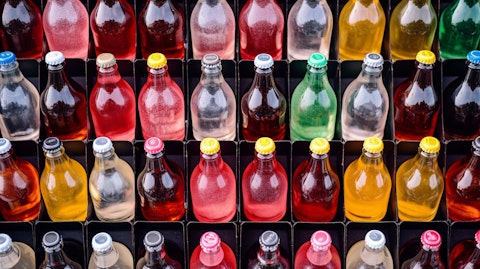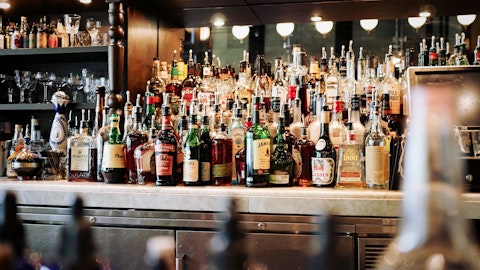Compañía Cervecerías Unidas S.A. (NYSE:CCU) Q3 2023 Earnings Call Transcript November 9, 2023
Operator: Good day, everyone and welcome to CCU’s Third Quarter 2023 Earnings Conference Call on the 9th of November. Today’s conference call is being recorded. At this time, I would like to turn the conference over to Claudio Las Heras, the Head of Investor Relations. Please go ahead sir.
Claudio Las Heras: Welcome, everyone, and thank you for attending CCU’s third quarter 2023 conference call. Today with me is Mr. Felipe Dubernet, Chief Financial Officer. You have received a copy of the company’s consolidated third quarter 2023 results. Felipe will now review our overall performance and we will then move on to a Q&A session. Before we begin as usual, please take note of our cautionary statement. The statements made in this call that relate to CCU’s future performance or financial results are forward-looking statements, which involve known and unknown risks and uncertainties that could cause the performance or results to materially differ. These statements should be taken in conjunction with the additional information about risks and uncertainties set forth in CCU’s annual report in our 20-F form filed with the US Securities and Exchange Commission and in the annual report submitted to the CMF and available on our website.

A colorful array of sparkling beverages in dozens of different containers on parade.
It is now my pleasure to introduce, Mr. Felipe Dubernet.
Felipe Dubernet: Thank you, Claudio, and thank you to you all for joining us today. During the third quarter 2023, CCU continued making progress to recover financial results and profitability in a challenging and volatile economic environment, the later is strong at the operation at the operational level, increasing consolidated EBITDA by 27.7% and improving 269 basis points EBITDA margin. The performance of the quarter shows that the path to improve our profitability under the regional plan HerCCUles is moving forward. However, stronger efforts are needed in the context of economic deacceleration and volatility in exchange rates and commodity prices. This drives us to focus on the pillars of HerCCUles. First, maintain business scale, strengthening revenue manageable efforts, deliver efficiency gains through our transformation program, optimizing CapEx and working capital, focusing on core brands and high-volume margin innovations and continue investing in our brand equity.
In quarter three 2023, our revenues expanded 0.4% explained by 5.1% increase in volumes more than offset by a 5.7% expansion in average prices in Chilean pesos. Lower volumes were caused by weaker consumption in Chile and Argentina and worst weather especially in Chile, while holding market share and a contraction in wine exports. The higher average prices in Chilean pesos were a consequence of revenue management efforts across all our operating segments. Gross profit jumped at 8.9% and gross margin rose 362 basis points the latter explained by the higher average prices and flat average cost of goods sold versus last year. The MSD&A expenses increased 2.9% and as a percentage of net sales grew 94 basis points mainly as a consequence of higher marketing activities, the latter to keep enhancing brand equity.
In-all, EBITDA reached CLP86,344 million up by 27.7%. Net income dropped 44.9% totalizing a gain of CLP9,499 million. [Technical Difficulty] during the quarter. And second CLP8,665 million of nonrecurring expenses related with the route — with the integration of the route to market of our JV in Argentina with our Danone into our beer and cider operation. In terms of cash generation, we delivered another robust quarter. Thus, as of September 2023 net cash inflow from operating activities totalized CLP205,681 million versus a negative cash inflow of CLP21,871 million. In 2022, while net cash outflow from investment activities reached CLP111,051 million, decreasing from the CLP175,168 million during the same period in 2022. In addition, we have decreased our portfolio complexity and recorded strong brand equity in [Indiscernible] being key to hold market share in our main categories.
In the Chile Operating segment, our top line expanded 5.1% explained by 4.7% decrease in volumes being more than offset by 10.2% growth in average prices. The higher average prices were explained by a robust revenue management initiatives that we have taken from end of last year. Lower volumes were explained by a challenging consumption environment along with unfavorable weather although in line with the industry as market share remains stable. Gross profit expanded 17.4% due to top line performance and lower cost pressures. MSD&A expenses were 12.3% higher and as a percentage of net sales grew 237 basis points mostly due to higher marketing activities. In all EBITDA reached CLP52,618 million, growing 38.7% and EBITDA margin increased 320 basis points.
In International Business Operating segment, which includes Argentina, Bolivia, Paraguay and Uruguay, net sales recorded 2.4% contraction in Chilean pesos as a result of 4.3% drop in volumes, partially offset by a 2% increase in average prices in Chilean pesos. Volumes were negatively impacted by a weaker consumption environment in Argentina, partially compensated by volume expansion in all the other geographies. Gross profit expanded 1.1%. MSD&A expenses decreased 6% and as a percent of net sales improved 167 basis points due to efficiencies, compensating high inflation and other cost pressures, especially in Argentina. Altogether, EBITDA reached CLP25,785 million, a 30.2% expansion from last year. The Wine Operating segment continued facing a tough business environment during the quarter.
Revenues were down 4.7% mostly explained by a 17.3% contraction in volumes while average prices increased 3.1% due to revenue management in the domestic market, partially compensated with negative mix effects. The lower volumes was explained by both a 14.4% fall in exports from Chile and a 14.8% drop in the Chile domestic market. Gross profit dropped 8.1% but gross margin improved 296 basis points due to higher average prices and a decrease in cost per liter, due to a more favorable cost of wine. MSD&A expenses were flat versus last year and as a percentage of net sales increased 429 basis points associated with the lower business scale. In all EBITDA reached CLP11,606 million a 21.2% contraction. In terms of our main JVs and associated business in Argentina volumes of our water business decreased low double digit mainly impacted by a challenging consumption environment.
Also we successfully continued with the route-to-market integration of this business. Finally, in Columbia, volumes contracted low single digit. Now, I will be glad to answer any questions you may have.
See also 12 Best German Stocks To Buy Now and 20 Most Valuable Video Game Companies in the World.
Q&A Session
Follow Clear Channel Communications Inc (NYSE:CCU)
Follow Clear Channel Communications Inc (NYSE:CCU)
Operator: [Operator Instructions] Our first question comes from Felipe Ucros from Scotiabank. Please go ahead, sir. Your line is open.
Felipe Ucros: Thanks, operator. Good morning, Felipe and team. Thanks for the questions. First let me start with volumes. Clearly, the volumes were not excellent in the quarter. When you look at the third quarter of each year for the past few years you’ve been coming down from a peak of 8.2, I think in 2021 than 7.9 in 2022 now 7.6. Do you think the post-pandemic correction is done should we be thinking about normalized volumes for hereon out? Or do you foresee that there’s a little more pain ahead given what’s happening with consumption in Chile?
Felipe Dubernet: Yes, first of all, comparing volumes nowadays volumes with 2021 and maybe 2021 especially is not the right comparison because you have 55 billion of pension funds withdraw in Chile and a boom in consumption. So is worth as 2020 was the year of the pandemic of the lockdowns, 2021 was the party in consumption in Chile, due to the pension fund withdraw. So I like especially to do a comparison with pre-pandemic volumes. This is from 2019. And total CCU volumes compared to 2019 to 2019 are 14% lower. And compared to third quarter of against third quarter 2019 is 10%. So the first pillar of HerCCUles is to preserve a scale to maintain scale both relative scale and absolute scale. And I think in this task, we are in this task.
Regarding the third quarter volumes, of course, we came from a volume — a reduction in volume in quarter one of 3.4%, but we were still comparing with a very high comparison in quarter one of 2022, because still we had the effect once again of the pension fund withdrawal. Then we had an excellent growth in the second quarter growing 4.8 volumes and minus 5%. And coming to Chile, of course, we decreased the volumes in quarter one minus 1.2%, because of the big comparison. So it was a very good volume. In quarter two, we grew 4.7% and now we decreased 4.7%. Of course, I think there is, two factors on that. The first factor has to do with temperatures. We have had a very rainy which is very good for Chile, as a country of course to have good level of rain, because we have drought conditions.
So it’s very good. So we had a lot of rain during July, August and the start of the spring and also cold temperatures. So the decrease in volumes in Chile, are partially explained by temperatures. On the other hand, of course, there is a deceleration in terms of consumption. And this — we have been always predictive on that because, HerCCUles is about maintaining scale. So overall, if you look at overall results in Chile, we are maintaining more or less scale in absolute terms, as we are bit practical in our volumes and our volumes in Chile are minus 0.7% less than last year. So overall, maintaining the scale. And in terms of relative scale, that take into account the market share we are holding even growing in some categories our market share positions.
That’s the scenery. Going forward, it’s difficult to predict. We will continue to face, I think a very — at least in the next few quarters maybe this acceleration not further — I don’t see a further deceleration in volumes. I see that we will be able to maintain the scale. I don’t see something different given that. Quarter-on-quarter, it will depend on whether, we depend on temperatures it’s impossible to forecast weather. There are some people that said that, we have a very hot summer, but I don’t know. I think meteorology is difficult — meteorology is a difficult science. But in a nutshell is what we see in terms of consumption.
Felipe Ucros: Okay. That’s very helpful, Felipe. So you essentially think that you’re more or less a new baseline for the company, right? Maybe if I can do a follow-up for costs, after you’ve had some very good quarters of improvement on costs in recent times. And it seemed that costs didn’t provide that much of a tailwind in this quarter. What’s your outlook for the next few quarters?
Felipe Dubernet: Yeah. Look, in terms of cost, I think, we had some good news, but also some bad news. I think we have bad news regarding the non-alcoholic business especially the non-alcoholic business given the sugar prices that are at historical level. And also orange juice. Orange juice the tailwinds are very bad for orange juice and sugar. In terms of grains it’s a question of carryover of inventories. As I said in previous communications of previous conference call last year, we benefit of pre-Ukraine prices for barley. That of course in the global market barley has been reducing the prices. However, we still have — in this year now we have benefit a lot of the pre-Ukraine cost level, but because of the opposite season that we have with Europe. But in general in the year we see stable cost — unit cost and a lot of pressure in non-alcoholic beverages given sugar prices and orange juice.
Felipe Ucros: Okay. That’s very clear. I’ll get back in the queue for few more questions if not ask. Thanks a lot Felipe.
Felipe Dubernet: Thank you. And have a wonderful day, Felipe.
Operator: Thank you very much. Our next question comes from Thiago Bortoluci from Goldman Sachs. Please go ahead, Thiago.
Thiago Bortoluci: Yes. Hi. Thanks, Felipe, Claudio for taking the questions and good afternoon everyone. I’ll like to follow-up now on SG&A, right? I see your efficiency ratio has marginally deteriorated and it seems that most of the pressure was due to marketing, right? Parallel to this we see Chile demand has been volatile. The company keeps pushing prices higher. So putting everything in perspective, I am wondering how much more marketing would you need to invest in order to keep scale amidst very volatile demand backdrop, right? And this is the first part of the question. And the second part of the question, assuming marketing will likely continue to be an important driver for you to keep volumes how much more efficiency the HerCCUles plan could extract in other lines eventually to partially offset this and protect your EBITDA margin? And that’s the question. Thank you very much.
Felipe Dubernet: Overall, I would say, you are right that the MSD&A increase a little bit in terms of percentage of, let’s say. I would say, we recover normal levels of marketing expenses this year compared to 2022. 2022 was a very tough year in terms of results. And one of the pillars of HerCCUles Pillar number six is about protecting or increasing our brand equity. And this is what is we are having because without brand equity you cannot have a good revenue good revenue management pricing and sustaining volumes. And this is what we — and we think we are investing for the long, long-term. So adding up also the manufacturing expenses, we are practically flat in terms of expenses as percentage of net sales. Overall, accumulated to the year.



